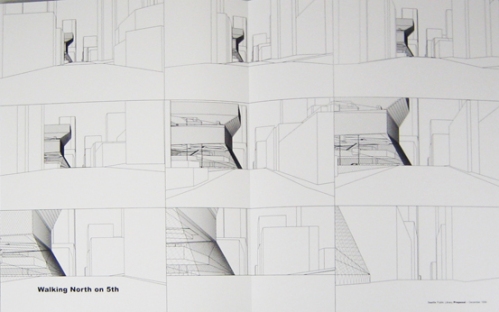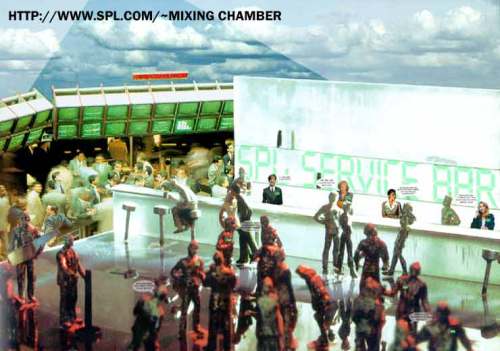Architecture does not solely exist in its spatial built form, but also (and sometimes almost exclusively) in several different mediums and/or representations. Several radical proposes from a wide range of architects, like Gaudi, Le Corbusier, Frank Lloyd-Wright, Archigram or Peter Eisenman exist in the collective memory of the discipline in their unbuilt form, in an array of mediums like texts, plans, sections, details, photographs, renderings, physical models, collages, among others. In this assortment of mediums, architecture has been conceptualized, explained and discussed.
Posts Tagged 'conceptual'
our project: introduction
Published March 11, 2008 project description 1 CommentTags: conceptual, framework, overview
physical model: book spiral
Published March 11, 2008 Uncategorized Leave a CommentTags: 3-D, architect, book spiral, conceptual, el croquis, general audience, interior, physical model, print, professional audience
In this instance the Seattle Central Library is represented by a physical model of the interior of the book spiral, the four story high floating box between the 6th and 10th floors. This model was created to show the inner workings of this space, particularly the continuity of book stacks, the relation between the rising slabs and the work stations in between. The book spiral was envisioned to be a built manifestation of the digital database of the holdings of this library, as a response to the uncertain evolution of the book collection of this library, and as a way to make as many books as possible easily and directly accessible on the stacks. Therefore, the continuous spiral ramp is the epitome of compartmentalized flexibility, since it is prepared to expand and contract within its confines according to the changes in inventory at almost the same pace as the digital database. This original addition to the architectural vocabulary of spaces, exposes the back end of data container (and its structure) in the aesthetic exercise of the cultural implications perceived on the front end, as patrons find their books catalogued under the Dewey decimal system visible on the circulation section of the ramp.
3-D wireframe: walking approach to building
Published March 11, 2008 Uncategorized Leave a CommentTags: 3-D, 5th avenue, architect, concept book, conceptual, exterior, general audience, perspective, print, rendering, wireframe
This sequence of images illustrates the approach to the Seattle Central Library by a pedestrian walking North on 5th Avenue. These images have been rendered to wireframe in 3-D Computer Assisted Drawing software, which in this situation was used to calculate the different perspectival views of the East and South elevations of the library, as well as of the surrounding buildings. The library is differentiated from the rest of the buildings by the higher level of detail, conveying a tactile impression of its glass and steel net envelope. Even if in this example the building is central in the images, there is an underlying focus on the absent presence of the human subject, which structures the entire storyboard. On the initial images it is only visible the unusual and dislocated silhouette of the building, but as the pedestrian approaches, the interior of the building and its floating platforms are revealed. In the later views of this sequence, the pedestrian curiously does not enter the library but passes just next to it. This seems to sustain the Benjaminian notion of architecture being collectively consumed and absorbed in a state of distraction. In this case, by not entering, the absent pedestrian appropriates this piece of architecture only by perception (or sight), entirely dismissing the complementary appropriation of architecture by use (or touch).
our project: representations of architecture
Published March 10, 2008 project description Leave a CommentTags: conceptual, framework, overview
The representation of architecture has been thoroughly traced and discussed across a broad historical period by architects, architectural critics and art historians alike. For this project, we take as our basis the notion, argued by Alberto Perez-Gomez, that “representation is never a neutral tool” (1998) or a simple depiction of a building, but that architecture has truly been shaped by exploring the tremendous potential and conforming to the inherent limitations to specific mediums.
collage: mixing chamber
Published March 10, 2008 Uncategorized Leave a CommentTags: architect, concept book, conceptual, general audience, human figure, interior, photograph, web
This collage depicts the mixing chamber on the 5th floor of the Seattle Central Library, on the top of the floating platform dedicated for meeting rooms. This sort of representations is usually devised not to transmit an actual impression of space, but an intention of experience and atmosphere in a certain space. In this case, we can observe how patrons and librarians interact in a constant flow of interdisciplinary information, creating a stimulating environment of exchange. Upon closer inspection, it is possible to read the dialogues between individuals, which create the basic structure and most important feature of this space, namely social interactions (which can seem odd, given that it is a library). Remarkably this impression is transmitted not only by the serious accumulation of several agents, but also by the creation of small disconnected narratives, which do not follow the traditional linear structure of several different pieces necessarily following one after another to constitute a whole, but the existence of all these parallel (and possibly interconnected) stories create and transmit the notion of diversity and fluidity intended for this space. Interesting analogies to other (familiar) spaces are also embedded in this collage, namely by the positioning of informational screens and bar stools, attempting to translate the innovative idea of a “mixing chamber” by approximation (or hybridization) of other existing spaces.
floating platforms physical model
Published March 10, 2008 Uncategorized Leave a CommentTags: 3-D, architect, conceptual, exterior, general audience, interior, physical model, professional audience, Rex, web
In this example, the Seattle Central Library is represented by the conceptual physical model of the organization of its interior spaces, namely the overlapping of the floating platforms of program. This model illustrates the duality of spaces created, particularly the enclosed spaces inside the boxes and the open spaces on top of them, generated by the notion of compartmentalized flexibility. Also evident is the vertical circulation system comprised of several escalators connecting the different floors. Functioning as a linear and sequential system, this sequence of spaces seems comparable to a landscape by the railway. While the train speeds by the surrounding landscape, patrons of the library are efficiently transported towards the top by the escalators crossing the different spaces, creating a similar dissociation between people and the traversed surroundings. However, the experience elaborated for the travelers on the escalators attempts to actively engage with our current mode of perception by offering several views of artworks during their ascent and descent, as well as some glimpses into the crossed spaces. This system of escalators also contributes to the creation of a hyper-connectivity or geographical space within this building, where importance is conceded to the connecting nodes and withdrawn from the spaces in between.
our project: virtuality of architecture
Published March 10, 2008 Uncategorized Leave a CommentTags: conceptual, framework, overview
As our specific topic, we consider the Seattle Central Library as an instance of architecture, not as a singular building, but instead, following the definition of architecture put forth by N. Katherine Hayles and Todd Gannon:
… we posit that architecture is a function of embodied discourse, that is, discourse instantiated in speech or, more typically, written or graphical documents…. Embodied buildings and embodied documents are physical objects witnessing to architectural acts, but architecture can never be reduced to these objects. Rather, architecture partakes fundamentally of the virtual in the Deleuzian sense, a nimbus of potentialities in dynamic interaction with the actuality of buildings and documents.
diagram: library programs – OMA Proposal
Published March 10, 2008 Uncategorized 2 CommentsTags: architect, conceptual, database, diagram, general audience, material, professional audience, Rex, virutal, web
From the OMA Concept Book.
This visualization of the library’s “programs” is the heart of the Library’s design, as confirmed by Joshua Prince-Ramus.
This is the visual slight-of-hand that transposes material books into a “program.” Other programs are: operations, parking, hq, reading, attraction, living room. As groups of functionality and processes, they are very much like computer programs. The metaphor extends to the separation and containment of like programs in five different platforms with “trading floor” areas in between. Again this reveals a database aesthetic rather than a narrative aesthetic — the chart is vertical, not horizontal, not linear, but hierarchical. It is not the linear processes themselves that are depicted but their (database) classification.
The transformation of the original bar of colors, put together by the library’s staff, to OMA’s “program reshuffled” chart very closely resembles the visual feedback of computer disc utility software defragmenting a hard drive. Clearly this is what OMA intends: they have optimized the hard drive that is the Library.
The underlying peculiarity is that the chart gives its programs which, as sets of processes, are not themselves material, a materiality by assigning them square footage. How the program-to-square-footage was formulated is a mystery.
our project: singular-general
Published March 9, 2008 Uncategorized Leave a CommentTags: conceptual, framework, overview
In order to frame and illustrate the general idea of architecture and its dissemination in different media, we have decided to analyze a singular piece of architecture which exists in several different mediums and representations, and which has been widely discussed in several different circle, namely the Seattle Central Library. From the specific and quite particular situation of the Seattle Central Library we expect to be able to draw some understanding of the process of how architecture copes and is expressed in different media produced by different agents for different audiences.
our project: why SCL?
Published March 8, 2008 Uncategorized Leave a CommentTags: conceptual, framework, overview
In Database Aesthetics, Victoria Vesna writes:
With rapid technological advances in access and retrieval of information through large computer databases, libraries are changing, and thus the way we form knowledge and narrative is also changing.
With this in mind, an actual library designed in and for the “age of information overflow” seemed like a particularly good subject for our examination of architecture from the perspective of our class (Media Theory for the 21st Century). We’ve focused here on topics of database, narrative, code, embodiment, techno-determinism, and media ecologies.
The building’s principle architect, Rem Koolhas envisioned the library of the future as “an information storehouse, orchestrating the coexistence of all available technologies.” Koolhaas has argued also that in the past the main concern was to find information; in the future it will be to select information.
As such we considered the Seattle Central Library a site of particular interest as a reflection of the “discourse network” circa 2000 and of the media ecologies of information-dissemination in the 21st century.
(For a discussion of the SCL as a database and an expression of database aesthetics, see SCL as database.)




